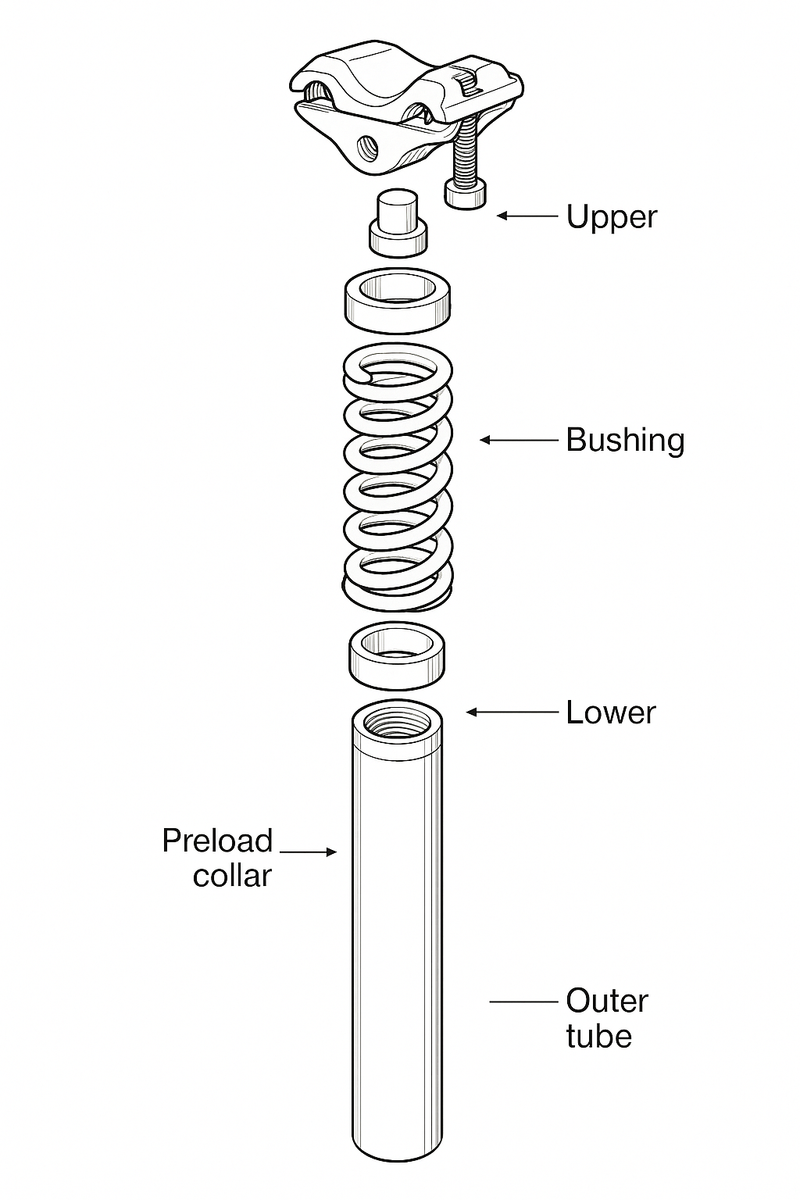Bouncing—a common issue with spring-based setups—can lead to discomfort and reduced control.
Electric bike riders often face a dilemma: spring seats with traditional coil systems or elastomer suspension posts designed to dampen vibrations.
The goal is simple: less bounce, more comfort, zero “pogo.” Which technology really keeps you planted?
This article explores whether elastomer technology truly outperforms springs in reducing seat suspension bounce, focusing on performance, adjustability, and long-term reliability for eBike riders.
Featured Summary
-
Elastomer seatposts self-damp rebound, so they feel firmer with noticeably less pedal-bob on smooth roads.
-
Coil-spring posts give plusher travel and are easy to service, but need careful preload to avoid bounce—especially on powerful e-bikes.
-
A parallelogram design (usually elastomer) keeps the saddle moving almost straight down instead of arcing toward the crank, improving pedaling efficiency.
-
Temperature swings slightly stiffen elastomers and speed spring-oil wear, yet normal riding ranges see only minor real-world change.
-
For commuters and cargo e-bikes, elastomers win on low maintenance and anti-bob. Trail riders chasing 35-50 mm travel still prefer coil-spring or hybrid posts.
Why Seatpost Bounce Matters on E-Bikes
E-Bike Weight Amplifies Impacts
Added battery and motor mass drive bigger vertical forces into the saddle, so vibration that a road bike shrugs off can feel like repeated hammer blows on an e-bike.
Health & Performance Costs
Chronic micro-shock increases lower-back fatigue and steals pedaling watts as your core stabilizes each bounce.
How Spring Seat Suspension Works
Coil Basics
A steel or titanium coil compresses linearly; rebound is controlled by friction in the post or an internal elastomer bumper.
The Pogo Problem
Without enough preload the coil releases energy like a pogo stick, creating the notorious “bob” many e-bike owners report.
Maintenance & Tuning

Swap spring weights to match rider load.
Grease the telescoping bushings every 2,000 km.
Re-check preload after adding a rear rack or child seat.
Recommended: Understanding Bicycle Gears: A Guide on How to Use Them
How Elastomer Suspension Works
Progressive, Self-Damping Action
Rubber-like elastomers compress quickly over small bumps, then harden under bigger hits, smoothing chatter without kickback.
Temperature & Aging
Cold weather firms elastomers slightly; heat and UV can accelerate long-term softening, though proper storage below 100 °F keeps life expectancy near a decade.

Real-World User Feedback
Riders switching from coil report crisper pedaling and quieter operation on city streets.
Spring vs Elastomer — Quick Comparison
Impact Absorption and Rebound Control
-
Springs: Excel at handling large impacts (e.g., potholes) but often oscillate after compression, creating a bouncy feel. Heavier riders may experience more pronounced bouncing due to spring tension limitations.
-
Elastomers: Provide progressive compression, reducing rebound velocity. The Thudbuster ST’s tunable elastomers, for instance, allow riders to match stiffness to their weight, minimizing post-impact oscillation.
| Feature | Coil-Spring Post | Elastomer Post |
|---|---|---|
| Typical Travel | 35–50 mm | 20–45 mm |
| Damping | Needs friction or hybrid elastomer | Built-in self-damping |
| Bounce on Smooth Asphalt | Moderate–High if preload wrong | Low |
| Weight Range | 550–750 g | 450–650 g |
| Service Intervals | 1–2× year grease + spring swaps | Inspect elastomers yearly; replace ~5 yrs |
| Cold-Weather Feel | Unchanged | Slightly firmer |
| Up-Front Cost | $$ | $$–$$$ |
Key Factors Influencing Suspension Choice
Rider Weight and Load
Heavier riders (>200 lbs) may prefer dual-spring systems (e.g., Cirrus Kinekt) for consistent support, while elastomers require careful tuning to avoid bottoming out. The Thudbuster ST’s weight-specific elastomer chart ensures optimal performance across sizes.
Maintenance and Durability
Springs: Require periodic lubrication and are prone to corrosion in wet climates.
Elastomers: Degrade over time (2–3 years with heavy use) but are weather-resistant and silent.
Cost and Compatibility
Spring Seats: Budget-friendly options start at $40 (Zoom), while premium models (Brooks) cost up to $150.
Elastomer Posts: Range from $100 (Thudbuster ST) to $300 (Kinekt 2.1), offering finer adjustability for eBike-specific needs.
Choosing the Right Seatpost
Urban & Commuter Riders
Pick a 27.2 mm elastomer post with 20-30 mm travel to tame potholes without sacrificing sprint power.
Off-Road & Adventure
A coil or hybrid post such as the Redshift ShockStop offers extra stroke for washboard gravel, provided you dial in spring rate.
Heavy & Cargo E-Bikes
Look for elastomer posts with interchangeable hard-compound blocks rated to 150 kg rider + cargo.
Recommended: What You Should Know About Hall Sensors for Electric Bikes
Optimizing Your eBike’s Suspension Setup
Hybrid Solutions for Balanced Performance
Combine a suspension seatpost (elastomer or spring) with a spring-equipped saddle (e.g., Planet Bike A.R.S.) for layered shock absorption. This setup reduces bouncing while maintaining pedaling efficiency.
Tuning Tips for Reduced Bounce
Preload Adjustment: Increase elastomer stiffness or spring tension to limit excessive travel.
Saddle Angle: A level seat prevents weight shifts that exacerbate bouncing.
Tire Pressure: Lower PSI (5–10% below max) enhances natural damping from tires.
Installation, Tuning & Care
-
Set Sag: Aim for 5–8 mm sag when seated to avoid bottom-outs or bob.
-
Match Spring/Elastomer Hardness: Most brands ship three densities—light, medium, heavy—to cover 50 – 120 kg.
-
Torque & Grease: Use 8 Nm on saddle clamp bolts; fresh assembly paste on seat-tube every 6 months.
-
Seasonal Check: In sub-freezing rides, expect elastomer posts to feel 5-10 % stiffer—no adjustment normally required.
Bottom Line — Is Elastomer Better?
For most e-bike commuters, tourers, and light-trail riders, elastomer seatposts strike the ideal balance of comfort, low maintenance, and anti-bounce stability. Coil-spring designs still rule when maximum travel or ultra-easy DIY service is the priority. Match the system to your weight, terrain, and willingness to tweak, and the days of saddle pogoing can be left in the rear-view mirror.
You can check out the following video recommendations for comfortable seating for your reference:


















